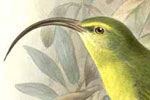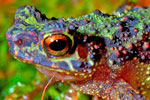.568.jpg)
The Bururi long-fingered frog was rediscovered after missing for 62 years. Photo by: David Blackburn.
A pair of researchers have rediscovered a long-lost frog in the tiny African country of Burundi. Known as the Bururi long-fingered frog (Cardioglossa cyaneospila), the species hadn’t been seen for over 60 years—since the Soviet Union tested its first nuclear weapon in 1949—but was rediscovered in Bururi Forest Reserve.
“I thought I heard the call and walked toward it, then waited,” said David Blackburn with the California Academy of Sciences in a press release. “In a tremendous stroke of luck, I casually moved aside some grass and the frog was just sitting there on a log. I heard multiple calls over the next few nights, indicating a healthy population of the species, but I was only able to find this one specimen.”
The Bururi long-fingered frog, measuring about (3.8 centimeters) 1.5 inches, is named for its extra long “ring finger” on each foot. The finger sticks out from its other digits much like the aye-aye’s extra long finger, which the lemur uses to skewer insects. But unfortunately almost nothing is known about the Bururi long-fingered frog, including the purpose of its especially long digit.
Blackburn, along with Eli Greenbaum with the University of Texas at El Paso, had traveled to Burundi with the goal of finding this particular species, since there were concerns it had already gone extinct. Burundi is one of the most densely populated nations in Africa and one of the poorest countries on Earth. Civil wars have plagued the country, causing many to fear much of its biodiversity had been wiped out.
However, Blackburn and Greenbaum not only rediscovered the Bururi long-fingered frog, but also documented dozens of amphibians that had never been recorded in Burundi before. In addition, they say they may have even found new species, although more research is needed to confirm this.
“Because Burundi is poorly explored, we’ve probably doubled the number of amphibian species known from the country. Once we demonstrate that Burundi contains rare and endemic species, we can work with the local community to make a strong case for preserving their remaining natural habitats,” Greenbaum says.
Despite the instability of the country, the 3,300 hectare Bururi Forest Reserve still contained rare birds and chimpanzees, according to the researchers. A travel website for Burundi says that 25 mammals and 117 birds have been recorded in the reserve.
Blackburn and Greenbaum’s specimen of the Bururi long-fingered frog was brought back to the U.S. for genetic analysis.
_2.568.jpg)
The underside of the Bururi long-fingered frog. Photo by: Eli Greenbaum.
_2.568.jpg)
Bururi town lies adjacent to Bururi Forest Reserve. Photo by: David Blackburn.
View Larger Map
Related articles
Rwanda and Burundi agree to protect rare forest area
(09/15/2008) Rwanda and Burundi have agreed to protect a large tract of tropical mountain forest that is home to chimpanzees, rare owl-faced monkeys, and other wildlife.
Deforestation rates jump in Uganda and Burundi, fall in Rwanda
(01/25/2006) Tropical deforestation rates have skyrocketed in Uganda and Burundi, while declining significantly in Rwanda according to mongabay.com’s analysis of data from the Food and Agriculture Organization (FAO) of the United Nations.
Extinct frog rediscovered in Israel
(11/21/2011) After its marshland was drained, researchers thought the Hula painted frog (Discoglossus nigriventer) had vanished for good. However a patrol at the Ha-Hula lake in Israel recently discovered a single female amphibian that turned out to be the long-lost, and long-sought, Hula painted frog.
Over 80 percent of rediscovered species still face extinction

(08/18/2011) Imagine if your job was to locate extinct species. In 2010, biologists with The Search for Lost Frogs set out on a tropical mission hoping to confirm the existence of frog species not seen in decades. The team recovered proof of four out of a hundred missing species, including a toad among the expedition’s Top Ten Amphibians list. According to a new study study in the open access journal PLoS ONE, such biological surveys are critical conservation tools to prevent the ‘romeo error’: the abandonment of conservation efforts due to belief that a species is extinct. The study, the first of its kind, found that rediscovered species are especially in danger of vanishing again, this time altogether, without targeted conservation measures.
First ever picture of long lost rainbow toad

(07/13/2011) Scientists are elated after the surprise rediscovery of a wildly-colored frog not seen for 87 years and never before photographed—until now. The Bornean rainbow toad, also known as the Sambas Stream toad (Ansonia latidisca) was rediscovered on Borneo in the Malaysian state of Sarawak by local scientists inspired by a 2010 search for the world’s missing amphibians by Conservation International (CI). Leading up to its search CI released the World’s Top 10 Most Wanted Lost Frogs (out of a hundred being searched for): the Bornean rainbow toad was listed as number 10.